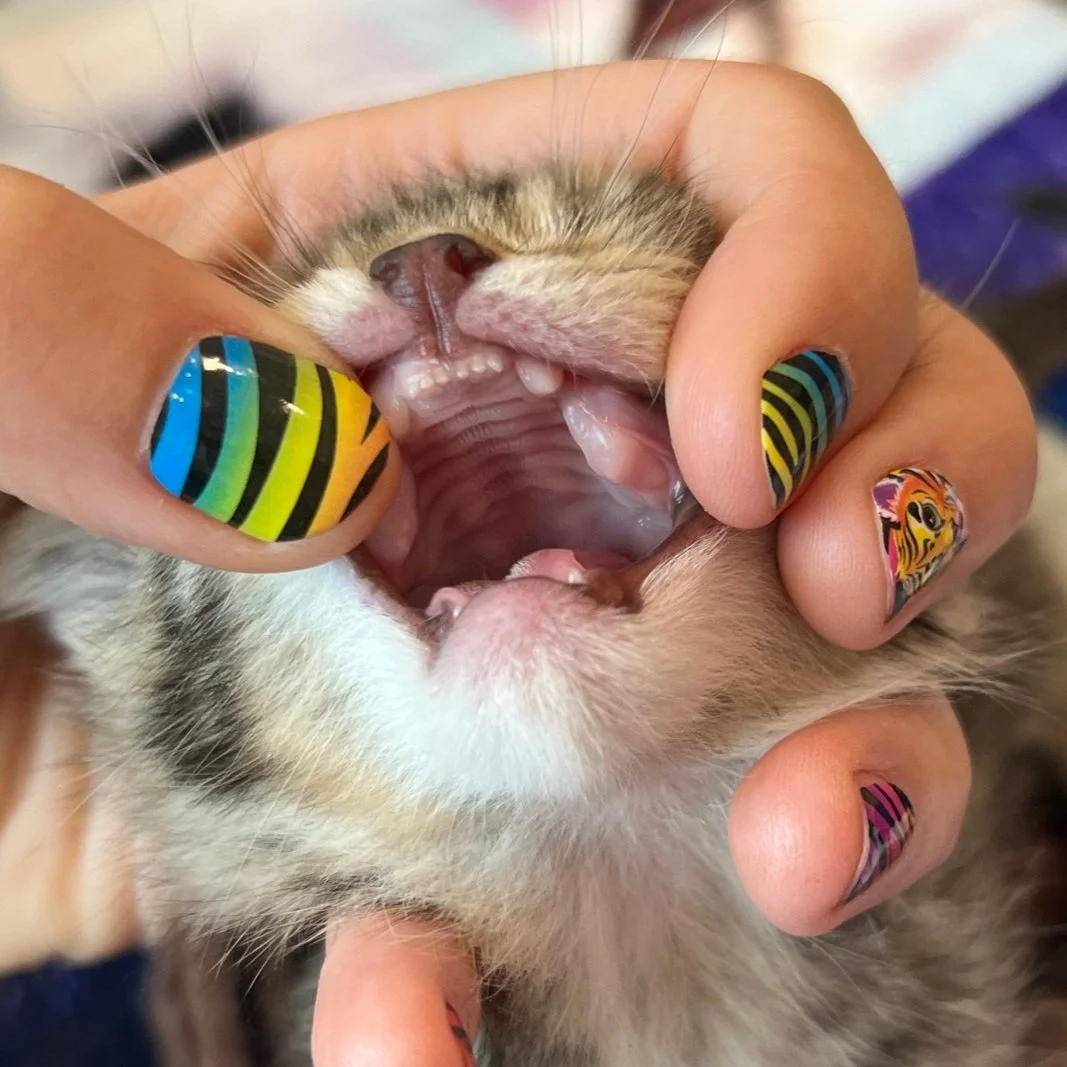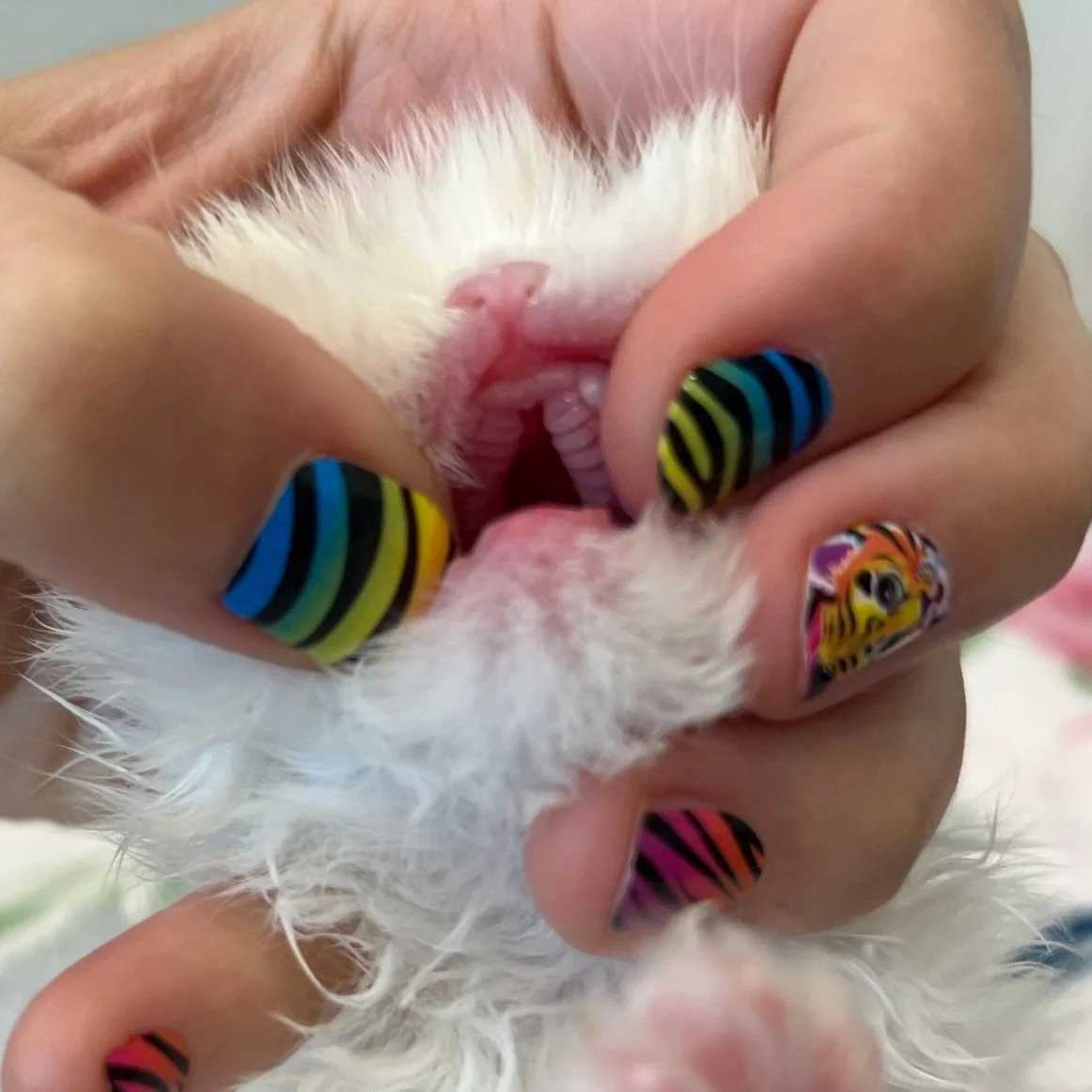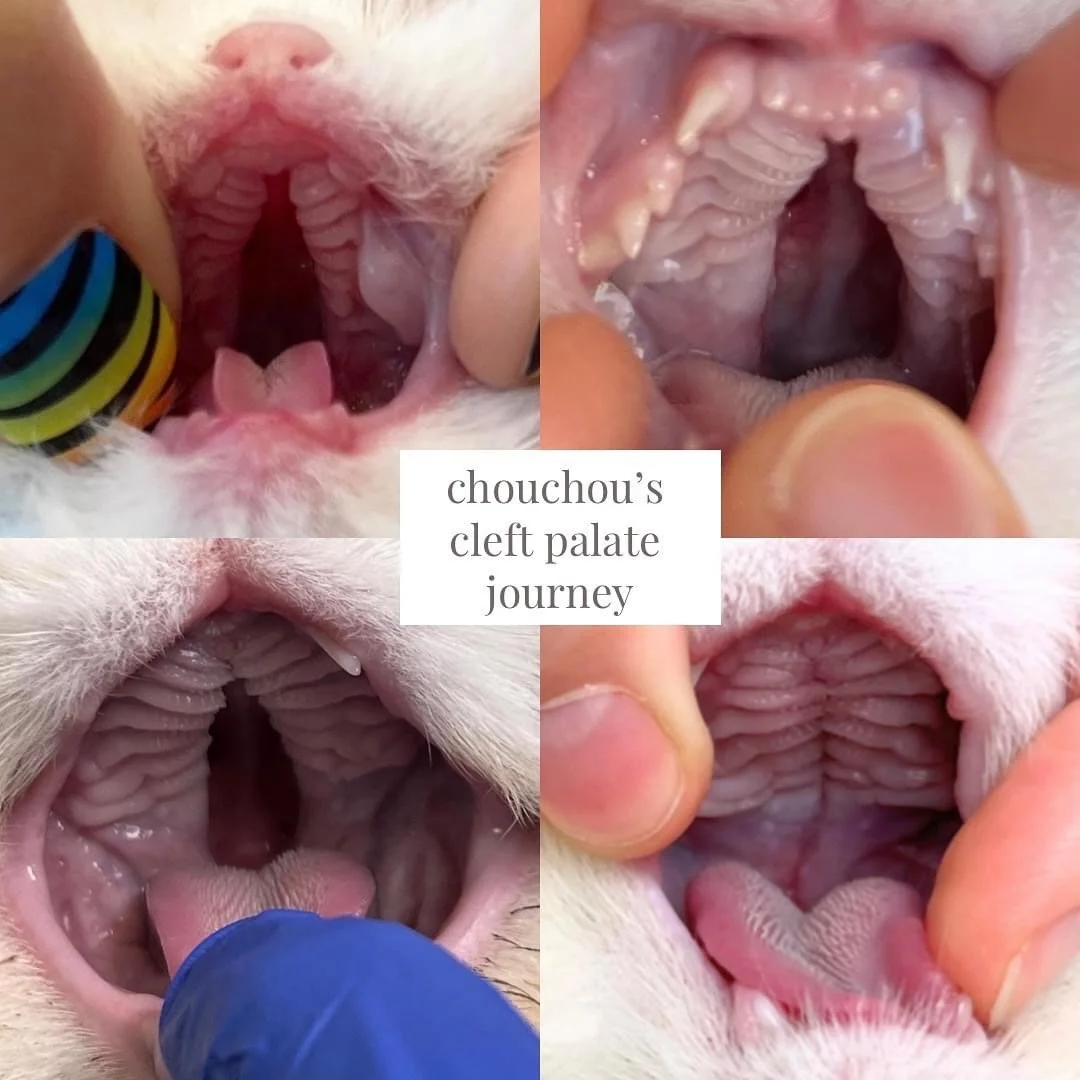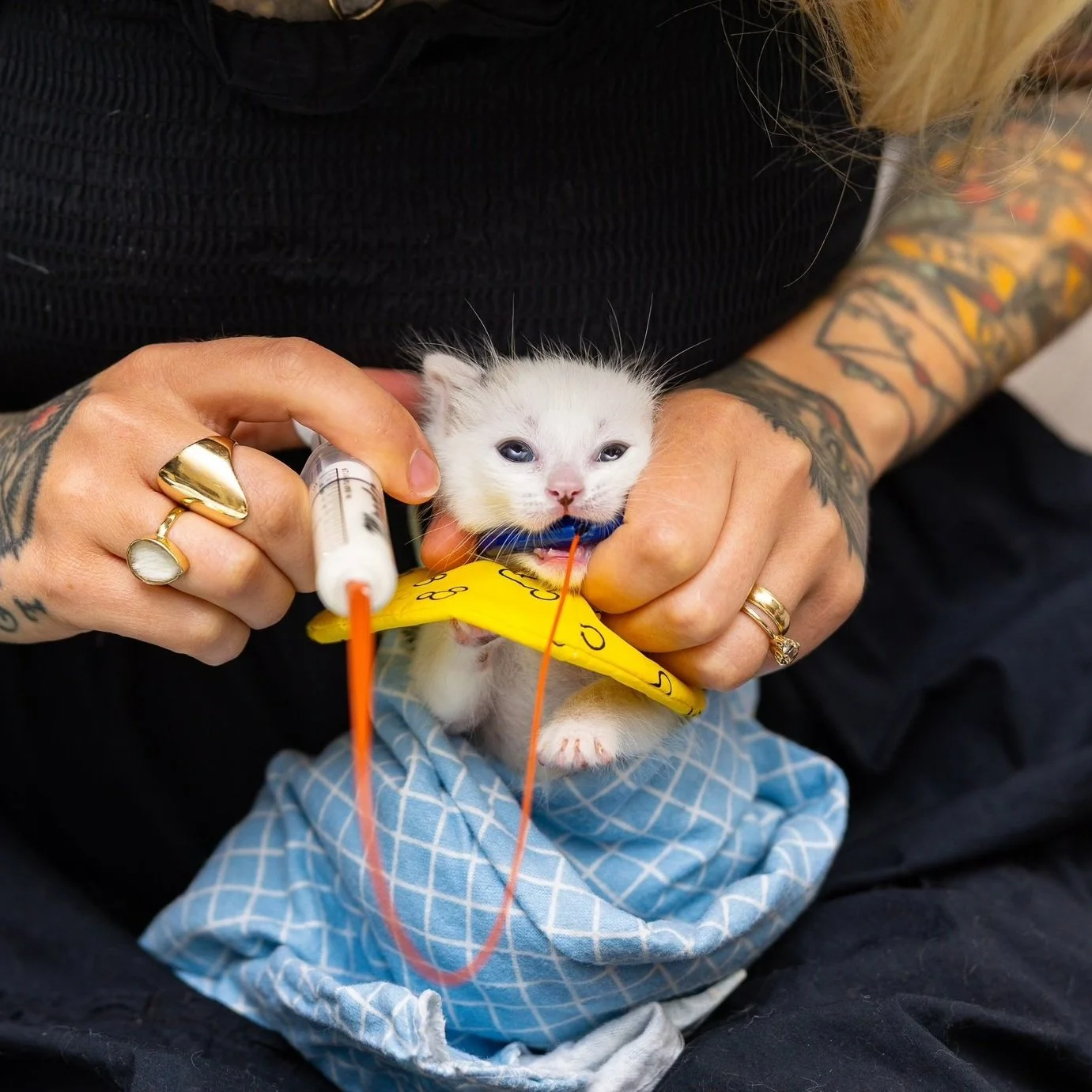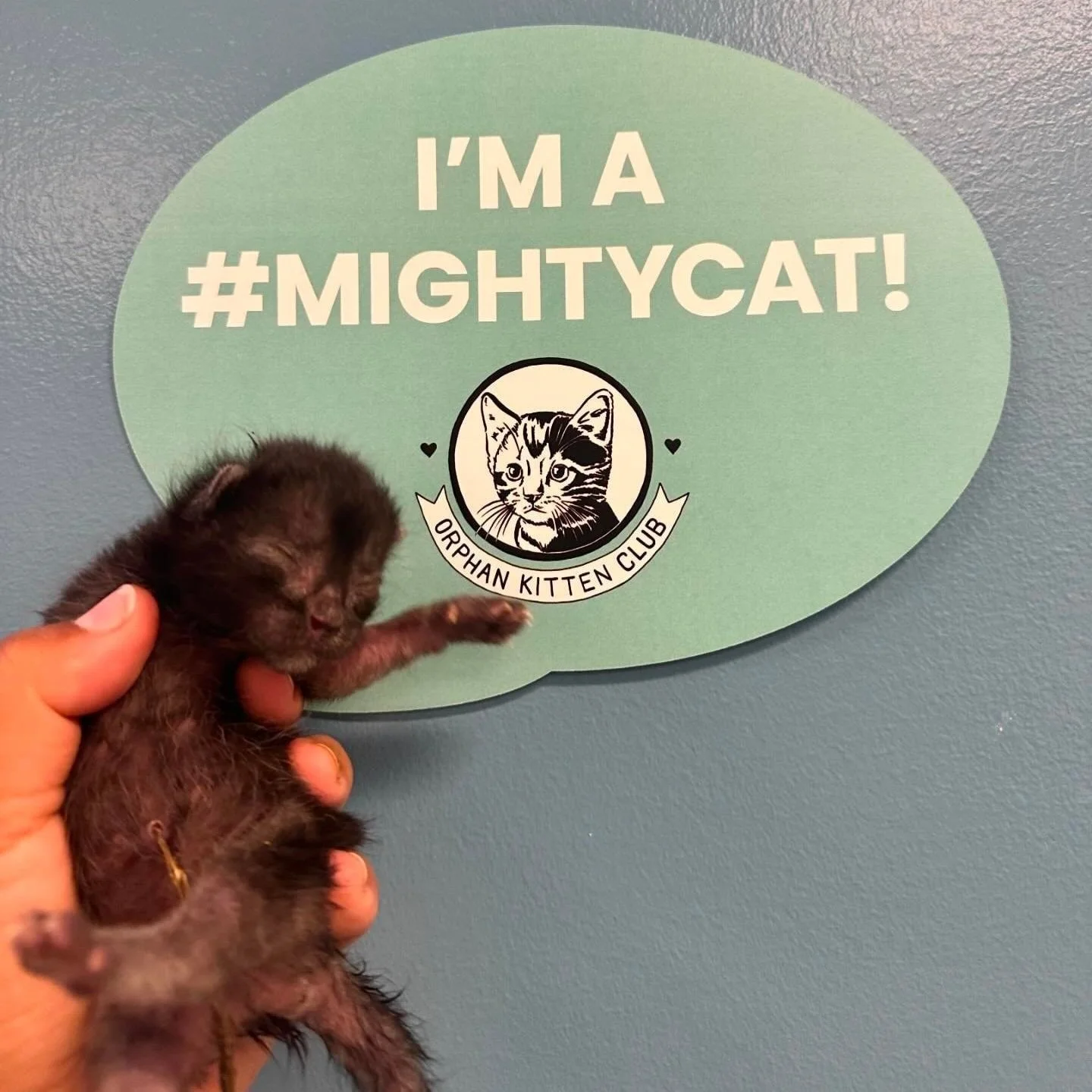How to Care for a Kitten With a Cleft Palate
Caring for kittens with cleft palates is no small task. These vulnerable babies face enormous odds, but with the right knowledge, commitment, and support, some of them do survive and thrive. Whether you’re a foster parent, shelter worker, or just someone who stumbled upon a kitten with a cleft palate, this guide is here to help you understand what’s going on and what it might take to help.
What is a Cleft Palate?
A cleft palate is a congenital birth condition where the tissues and bones that form the roof of the mouth don’t fuse together properly during fetal development. This creates an opening between the oral and nasal cavities, making it impossible for a kitten to safely nurse. Kittens with severe cleft palates sadly have extremely low odds of survival without specialized intervention, and for that reason many of these kittens are euthanized.
How to Tell if a Kitten Has A Cleft Palate
As a best practice, it’s a good idea to look inside the mouth of any newly rescued newborn kitten to check for a cleft palate. But in many cases, cleft palates are first suspected when a caregiver has a newborn kitten with worrying respiratory symptoms while nursing.
Warning signs in a newborn kitten:
Milk coming out of the nose during feeding
Frequent sneezing or coughing after feeding
Struggling to latch or nurse effectively
Gurgling or crackling sounds while breathing
Signs of respiratory distress or pneumonia
If a newborn exhibits these signs while nursing, it’s paramount to look inside their mouth. While a cleft lip can be easily noticed, a cleft palate is only visible if you open the mouth and look for a deficit in the palate. Some cleft palates are obvious—like giant opening in the roof of the mouth—while others may be just a small hole that is harder to spot without careful examination.
Take a peek inside Miss Furonica’s mouth. The roof of her mouth is solid.
This kitten has a normal palate:
Now take a look at Chouchou. There is a large hole in the roof of his mouth.
This kitten has a cleft palate:
If You See a Cleft Palate, Stop Feeding Immediately
If your kitten has a cleft palate, you’ll need to immediately remove them from nursing, whether on a bottle or with mom. The only safe way to feed a kitten with a cleft palate is by tube feeding, which bypasses the mouth altogether and requires special supplies and training. If you don’t have access to tube feeding supplies or training, you’ll need to go immediately to a veterinarian who can provide either tube feeding supplies and training, or euthanasia.
If you have a newborn kitten with a cleft palate, please know that the only chance of survival is with an experienced tube feeder.
Choosing How to Proceed
Due to the complexity of these cases and the likelihood of a poor outcome, organizations and caregivers should carefully consider whether they have the resources to proceed with care. Caring for a cleft palate kitten is a serious commitment involving 6+ months of specialized feeding leading up to an expensive, complex surgery that is not offered by every dental surgeon.
Unfortunately, even in experienced hands, many of these kittens will not survive to surgery age due to complications that can occur during the first weeks or months of life. While it’s heartbreaking to say goodbye to a kitten whose life is just beginning, euthanasia is the most humane option if the kitten will be unable to access safe tube feedings with a dedicated, trained caregiver, and/or if surgery will be inaccessible in the future.
That being said, if you’re up for the task and have the resources to help, I applaud your fortitude…and am here to guide you!
Chouchou’s palate as a newborn, at 2 months, at 6 months and at 9 months (post-repair.)
Chouchou’s Journey
Chouchou weighed just 60g when he came into my care through Orphan Kitten Club. We successfully kept him alive until surgery age—and his surgery was a success! He is now a healthy adult cat living his best life. You can watch his entire journey in this video playlist.
The information below is based on Chouchou’s case and my subsequent mentorship of other similar cases. Be sure to seek veterinary guidance about your kitten’s specific case.
The Risk of Aspiration
Cleft palate kittens are at high risk of aspiration pneumonia, a potentially fatal condition that happens when a foreign substance gets into the lungs. Due to the opening in the roof of the mouth, food is nearly guaranteed to end up in the respiratory tract, causing infection, respiratory distress, and death. Aspiration pneumonia can also occur if a kitten vomits, and for this reason it’s essential not to over-feed them when tube feeding. Sadly, many kittens are already suffering from aspiration pneumonia by the time the cleft palate has been discovered, at which point it can be a significant challenge to help them recover.
Kittens with cleft palates cannot:
Nurse from a mother cat
Consume formula or food by mouth
Have access to other animals’ food, water dishes or treats
Take medication by mouth
Vomit or regurgitate without risk of aspiration (for this reason, tube feeding should always be done slowly and in a careful volume.)
If a kitten has already aspirated, seek veterinary care immediately. Kittens with mild pneumonia may be able to recover with antibiotics, oxygen and other supportive care; in severe cases humane euthanasia may be the most compassionate option.
The Risk of Rhinitis
Kittens with cleft palates are also at risk of developing rhinitis, a painful inflammation of the nasal passages. Because the oral and nasal cavities are not properly separated, there is constant exposure to saliva, stomach acid and possibly even small bits of regurgitated formula or food that can cause irritation and infection. Over time this can lead to chronic nasal discharge, congestion, sneezing, and difficulty breathing—all of which can compromise the kitten’s comfort and health.
Supportive care for rhinitis may include nebulizer treatments, antibiotics, and saline nasal flushes. Throughout the course of care, you may want to keep a saline nasal flush on hand for any times that the kitten seems to be experiencing nasal irritation. Being aware of this risk and acting quickly at the first sign of nasal irritation is key to keeping cleft-affected kittens as healthy and comfortable as possible.
It’s a good idea to establish care with a vet right away so that you can quickly address and treat any problems that arise.
What to Expect When Caring for a Cleft Palate Kitten
Kittens with cleft palates will go through several phases of care as they grow. While it’s natural to want to plan ahead, the most important thing for you to focus on is the phase of care you are currently in, and the one coming next. I encourage you not to project too far into the future, as most veterinary surgeons will not even consider discussion of surgery until the kitten has survived through the first phases of care. Here’s what to expect during each phase:
0-4 weeks: During this time, you’ll be doing standard orogastric (OG) tube feeding with a kitten formula using a 3.5 Fr or 5 Fr tube. Should you require tube feeding training, I suggest you learn this in person with a professional or a highly trained caregiver, as learning online may not be a safe format. If you’re unable to access training, I recommend that you go to a veterinary hospital or locate a local rescue that is able to accommodate a tube-dependent kitten. Tube feeding comes with many risks, so please only do this with training.
When caring for a tube-dependent kitten who needs long term tube feeding, you’ll want to calculate both their stomach capacity and energy requirements regularly in order to ensure safety, proper growth, and healthy development. Your feedings should be lower than the upper stomach capacity, and higher than the minimal energy requirement. See “Calculating Feedings” section below.
It’s a great idea to establish care with a veterinarian for the kitten at this age, but don’t expect a surgical option to come quickly or easily. Mild cases (like a tiny hole) may be reparable earlier, but for moderate or severe openings, the kitten will likely need to be at least 6 months old before surgery with a specialist is an option. At this appointment you’ll just be establishing care, discussing nutritional support, and perhaps seeking a referral for future surgery.
Watch my videos on Chouchou, a Cleft Palate Kitten, During his first weeks of life and first vet appointment:
4 weeks: As the kitten grows, her teeth will be coming in—which means your tube feeding strategy will need to change. While safety is less of an issue with the incisors (which emerge around 3 weeks) and the canines (which emerge around 4 weeks), once the premolars erupt around 5 weeks, it is no longer safe to tube feed without use of a bite guard due to the almost certain risk that they will bite the tube and swallow it. This can lead to fatality or a need for emergency surgery. For this reason, you are strongly advised to begin bite guard training before the premolars emerge, around 4 weeks of age.
A bite guard prevents the kitten from biting down on the tube. This bite guard is crafted using a dental suction tube.
How to make a bite guard: My preference is to use a dental suction tube (called a saliva ejector) with a hole drilled through the center, which is then bent into a curve that can fit into the mouth and be held around the sides of the kitten’s head. This material retains its shape, is soft enough not to damage the teeth, and is durable. The hole should be big enough that the tube can comfortably glide in and out of it. Be sure to order the supplies with enough time to begin bite guard training at four weeks.
I also recommend that you switch to a 5 Fr tube at this age, as you will have a much easier time using it along with the bite guard.
Consider using a soft e-collar to help the kitten stay contained and to reduce the possibility of them pulling out the tube. It’ll feel very awkward at first, but over time this becomes a routine they understand and look forward to!
The bite guard is placed first and removed last—ensuring that the tube can’t be bitten at any point.
A soft e-collar helps keep the kitten in place and reduces the possibility of them pulling out the tube.
6+ weeks: By six weeks, kittens are normally eating meat—but that isn’t possible with a cleft palate kitten at this age. Instead, you’ll need to switch to a calorie-dense liquid meal replacement like Emeraid Sustain. Think of this transition as your “weaning” period for the kitten, but rather than weaning onto meat you’re weaning onto a meat replacement that can fit through a tube. A few things to note:
When tube feeding for long periods, it’s essential to get the nutrition correct because every drop of food they eat is coming from you. You are strongly advised to speak with a veterinarian who can make you an appropriate meal plan for the kitten as she grows.
Kitten formula is not an appropriate meal for a kitten after 6 weeks; it is not calorically dense enough to meet their growth needs and doesn’t contain the nutrients they need for this phase of development.
Wet kitten food will not be an option because it will only fit a feeding tube if substantially watered down—and once it’s made thin enough to fit through a tube, the amount you can safely fit into their stomach won’t provide enough calories.
Ask your vet about a high calorie liquid meal replacement. I use Emeraid because it has high energy density, fits nicely through a tube, and meets the AAFCO nutritional requirements for all feline life stages.
Read the “Calculating Feedings” section below to learn to measure the kitten’s nutritional needs correctly, being mindful of both stomach capacity and caloric requirements.
Watch my video on how Chouchou Ate:
8+ weeks: Now that your kitten has survived to 2 months, you may decide to schedule a vet appointment to find out if they’re a good candidate for an esophagostomy tube. An E-tube is a tube that is surgically placed in the esophagus with the port on the side of the neck, so that the caregiver doesn’t need to physically place an orogastric tube at each feeding. For some kittens, this may be a good option, but for others it may be best to stick to OG tube feeding with a bite guard until they’re a bit bigger. If sticking with OG tube feeding, you might even move up to an 8 Fr at this age.
Risks: All surgeries carry some risk. With this procedure, the greatest risks are anesthetic complications (no more risky for them than any other surgery), or that the kitten may regurgitate due to the new method of feeding, which can lead to aspiration in a cleft palate kitten. This can be partly mitigated with an anti-nausea medication injection and very slow feedings.
Considerations: If you have been OG tube feeding and measuring to the lower rib, you may be feeding lower in the GI tract than the E-tube will be placed. Rather than the food going into the stomach, an E-tube will deliver the food into the esophagus, which means you’ll need to depress the syringe extremely slowly so that you don’t flood the esophagus—and so that you give it ample time to empty through the lower esophageal sphincter. Some kittens will adjust well to this, while others may not. Finally, consider that as the kitten grows, the tube will need to be adjusted or re-placed because the esophagus will lengthen.
3+ months: As the kitten grows, you might choose to try some supervised, one-piece-at-a-time feedings of either a kibble or a (rehydrated) dehydrated food pellet. Wet food will not be a safe option. Instead, you may try providing one piece at a time of food that can be swallowed whole, such as kibble (as seen here) or a flattened rehydrated pellet food (as seen here.) It is important that the kitten swallows these whole and does not chew or break the food into small pieces that go into the nasal cavity. If they are able to safely swallow the food without issue, this is a good method—otherwise, continue with the tube.
4 months: At this age, it’s time to get on the radar of a dental specialist who specializes in cleft palates. Not all dentists will be comfortable with this procedure, so call around and ask, or ask your veterinarian for a referral. In the past I have used Dr. Boaz Arzi at UC Davis in California. Plan to send over any records and schedule your appointment for 6 months old or so based on their recommendation.
6-7 months: Around this age, you should have your consult with a dental specialist who offers cleft palate repairs. They will take imaging and measurements to see what type of surgery the kitten is eligible for. In severe cases, the kitten’s teeth will need to completely erupt so that the upper molars can be removed. Once healed, this creates more tissue that can be used for the eventual cleft palate repair. After the dental is done (between 6 and 7 months old) the kitten will need to heal completely before the final surgery.
7-8 months: If the kitten is eligible, a cleft palate repair surgery can occur. Note that there are different surgical approaches and only after a full assessment with a veterinary specialist will you know what, if anything, your kitten is eligible for. You can read the case study on my kitten Chouchou, who underwent a process involving a surgical “flap” of the buccal mucosa and palatal tissues, on the UC Davis website.
Watch my video documenting the process of getting Chouchou his surgery:
Calculating Feedings
Throughout the duration of tube feeding, you’ll need to regularly calculate the kitten’s stomach capacity and energy needs. This is a delicate balance between the density of the food (so it can fit through the tube), the capacity of the stomach (so you don’t cause regurgitation), and the energy needs of the kitten (so they develop and grow properly.)
Stomach capacity: 4% of the kitten’s body weight in grams is generally considered a healthy kitten’s stomach capacity in milliliters (.04 x body weight in grams = stomach capacity in ml.) Example for a 150g kitten: .038 x 150 = 6ml stomach capacity. However, many of these kittens are not healthy, and they also have a heightened risk with regurgitation or vomiting; for this reason I recommend against tube feeding these kittens to their full stomach capacity.
Instead, calculate around 3.8% of their body weight (.038 x body weight in grams = target feeding volume in ml.) Example for a 150g kitten: .038 x 150 = 5.7ml target feeding volume. Note that when first offering tube-fed meals, you should go even lower than this at about half their stomach capacity, and slowly increase the volume.
Energy requirement: This is the amount of calories (called kcals) your kitten needs to eat in a day in order to grow.
To measure a kitten’s daily energy requirements, first calculate their resting energy requirements using this formula: 70 x (body weight in kg)^0.75 = kcal requirement per day. Be sure you have your decimals right here—you’re using kilograms. Example for a 150g kitten: 70 x .15^0.75 = 17.19 kcals per day is their resting energy requirement.
Next, multiply that number by 2.5 to get their growth energy requirement. RER x 2.5 = kitten growth energy requirement. Example for a 150g kitten: 74.5 kcals x 2.5 = 43 kcals/day is the growth energy requirement for the entire day of meals.
Now, you want to divide the kcal/day by the number of kcals per ml in your food to find out the volume the kitten needs to eat per day. Example for a 150 gram kitten eating Breeder’s Edge: 43 kcals ÷ 0.93 = 46.24 ml per day
Here are some of the kcal/ml amounts for formulas and meal replacers you may use (along with their water to powder ratio), but you should confirm the kcal/ml on the product you’re using regardless:
Breeder’s Edge Feline Milk Replacer mixed 2 to 1: 0.93 kcal/ml
Kitten Milk Replacer mixed 2:1: 0.84 kcal/ml
Emeraid Sustain Feline Recovery mixed 2 to 1.5: 1.53 kcal/ml
Emeraid Intensive Care HDN mixed 2 to 1: 1.13 kcal/ml
Finally, divide the ml per day by the number of feedings per day to calculate the volume in ml per meal. For a 150 gram kitten eating Breeder’s Edge: 46.24 ml/day ÷ 8 meals a day = 5.78 ml per feeding. Compare this to the upper stomach capacity of 6ml and the target feeding volume of 5.7ml, and breathe a sigh of relief that you’re right on target!
Phew! I know that’s a lot. Don’t worry about doing this every day, but make sure you’re referring to these calculations at least weekly to make sure you’re on track. And of course, talk to a vet to ensure a proper nutrition plan!
Other Considerations
If you’ve made it this far, you can see how complex these cases are! You may have many questions remaining. Here are some final considerations:
Water: Be cautious about offering water to kittens with cleft palates, as it could cause issues if taken by mouth. Instead, try offering it in a hamster bottle to see if that can be done safely. The bottle should be above the kitten’s eye line, requiring them to actually lift their head in order to drink. This method worked well for Chouchou!
Medications: Oral medications are not an option for a cleft palate kitten unless given by tube. Ask your veterinarian for alternatives like injections or transdermal mediations. Otherwise, plan to give them with the feeding tube.
Bite Guard Feeding Help: Tube feeding with a bite guard feels very awkward at first, for both you and the kitten. If struggling, try using an upside-down e-collar or a soft blanket to reduce the activity of the kitten’s limbs and help things go smoothly. Over time, the kitten truly will learn to use the bite guard—but it takes practice!
If the Kitten Passes
While success is possible, I want to be transparent that death is a common outcome for kittens with cleft palates. If this happens to you, please know that it happens even to very experienced caregivers and can be due to factors outside of your control. Read my article on grieving the loss of a foster kitten and please be kind to yourself as your process the loss.
If the Kitten Survives
If you’ve successfully made it through surgery, congratulations! Kittens with cleft palate repair can go on to live normal lives, and they’ll be forever grateful to you for your intense dedication during the first months of life. It’s one of the hardest cases to take on as a rescuer, so please know you have my utmost respect!
If you saved a cleft palate kitten using this protocol, I’d absolutely love to hear your story. Tag me on social media so that I can give you a virtual high five!
Contribute to Save Cleft Palate Kittens
Treble is one of the many kittens with cleft palates and congenital conditions saved thanks to Orphan Kitten Club medical grants.
If you’d like to help save the lives of kittens with cleft palates and other congenital conditions all across the United States, please consider making a tax-deductible donation to Orphan Kitten Club.
Orphan Kitten Club is a national 501c3 providing lifesaving grants to save kittens with complex medical needs in shelters, including those with cleft palates. Check out this inspiring video about a kitten from a Kansas animal shelter who had his cleft palate repaired thanks to a grant from Orphan Kitten Club.



